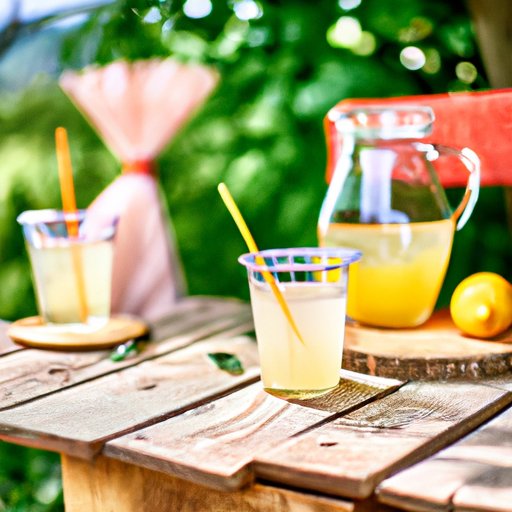
Introduction
There’s nothing like a cold glass of lemonade on a hot summer day. While store-bought lemonade is always an option, nothing beats the taste and satisfaction of homemade lemonade. In this article, we’ll provide you with a classic recipe for homemade lemonade, health benefits, cultural significance, occasion suggestions, presentation ideas, and even a kid-friendly tutorial. By the end of this article, you’ll be an expert on everything lemonade!
Making your own lemonade is not only delicious, but it’s also a great way to avoid unnecessary additives and preservatives found in store-bought drinks.
Classic Recipe with Variations
The classic recipe for homemade lemonade only requires three simple ingredients: lemons, sugar, and water. To make the recipe, cut and juice six lemons and combine with one cup of sugar and eight cups of water. Mix well until the sugar is dissolved. Adjust the sweetness and tartness of the lemonade to your preferred taste by adding more sugar or lemon juice.
If you want to mix things up, try adding different herbs or spices for flavor variations. Mint leaves, lavender, and ginger all make great additions to traditional lemonade.
Health Benefits and Alternative Sweeteners
Making your own lemonade is not only delicious, but it also offers several health benefits. Lemons are rich in vitamin C, antioxidants, and electrolytes, making it a great drink to quench your thirst and promote hydration.
To make your lemonade even healthier, try alternative sweeteners to sugar. Honey, agave nectar, and maple syrup are all great options. You can also add sliced fruit or berries to add natural sweetness and a burst of flavor.
Cultural Significance
Lemonade has different cultural significances in different parts of the world. In the United States, it’s a classic summertime drink enjoyed at picnics and backyard barbeques. In France, it’s called “limonade” and is served as a refreshing beverage during the hot summer months. In Japan, it’s not uncommon to find a fizzy version of lemonade in vending machines.
Historically, lemonade dates back to medieval Egypt, where sugar was first introduced to the region. Sicily, Italy, was one of the first regions to cultivate lemons, and the drink was then introduced to Europe by Arab traders. Today, you can find traditional recipes for lemonade from all over the world.
Occasions and Presentation Ideas
Homemade lemonade is a perfect beverage for any occasion. It’s a refreshing drink for a hot summer day, a great accompaniment to a picnic, and the perfect addition to a cocktail party. You can also add fresh fruit and ice cubes to create a stunning presentation guests will love.
For a fun twist on traditional lemonade, try adding raspberry puree or a splash of pineapple juice. You can also serve your lemonade in a signature cocktail glass and garnish with fresh herbs like rosemary, thyme, or basil.
Kid-Friendly Tutorial
Making homemade lemonade is a fun activity for kids. To make kid-friendly lemonade, combine one cup of lemon juice with two cups of water and 1/2 cup of honey. Mix well until the honey is dissolved and add ice cubes and fresh fruit for added fun.
To make the experience more interactive, try hosting a lemonade stand or lemonade-making party with friends. You can also engage kids by teaching them about the nutritional benefits of lemons and how to make different flavor variations using herbs and spices.
Conclusion
Homemade lemonade is a refreshing and healthy drink that can be easily made with a few simple ingredients. Whether you want a classic recipe or a new twist on the traditional drink, we hope this article has provided you with all the information you need to make the perfect homemade lemonade.




